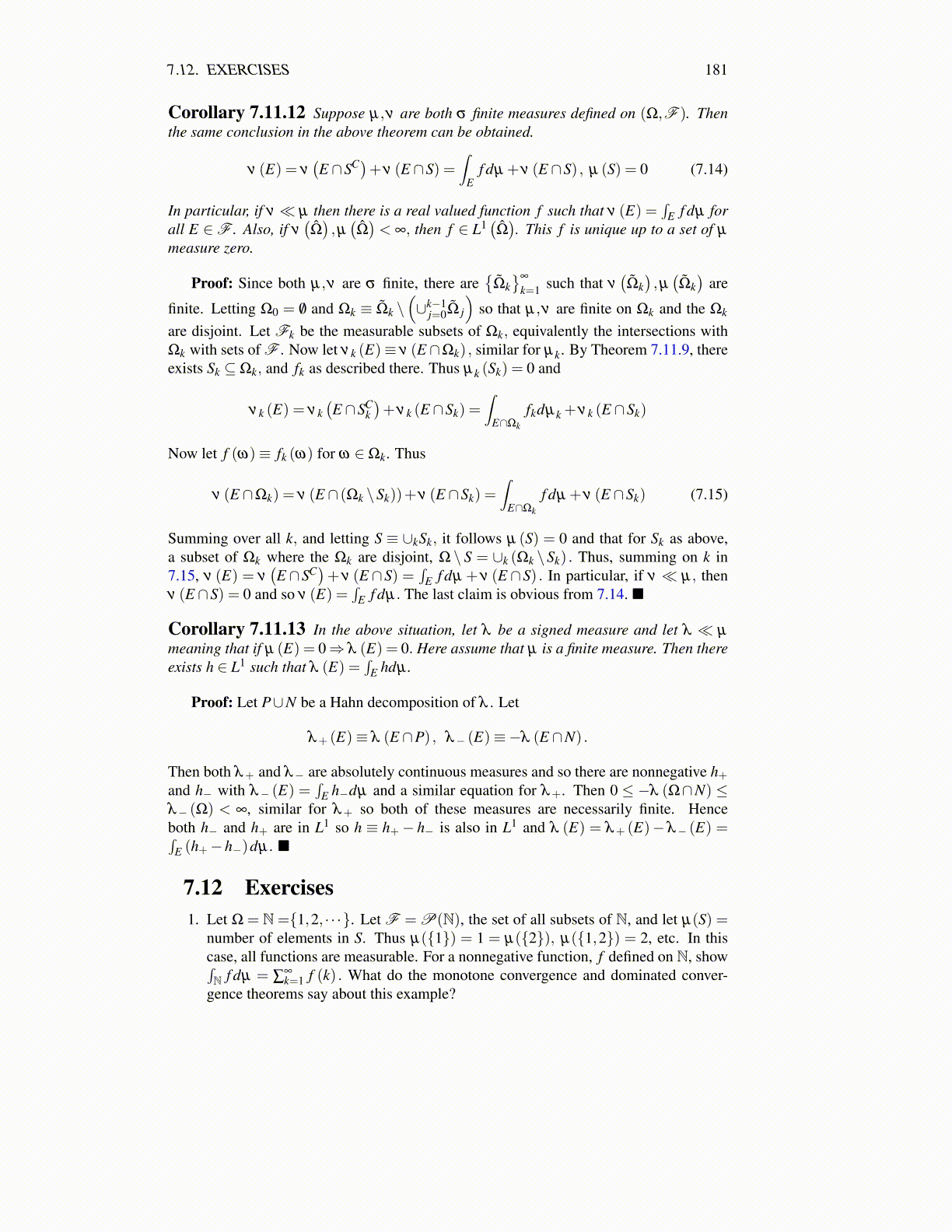
7.12. EXERCISES 181
Corollary 7.11.12 Suppose µ,ν are both σ finite measures defined on (Ω,F ). Thenthe same conclusion in the above theorem can be obtained.
ν (E) = ν(E ∩SC)+ν (E ∩S) =
∫E
f dµ +ν (E ∩S) , µ (S) = 0 (7.14)
In particular, if ν ≪ µ then there is a real valued function f such that ν (E) =∫
E f dµ forall E ∈F . Also, if ν
(Ω̂),µ(Ω̂)< ∞, then f ∈ L1
(Ω̂). This f is unique up to a set of µ
measure zero.
Proof: Since both µ,ν are σ finite, there are{
Ω̃k}∞
k=1 such that ν(Ω̃k),µ(Ω̃k)
are
finite. Letting Ω0 = /0 and Ωk ≡ Ω̃k \(∪k−1
j=0Ω̃ j
)so that µ,ν are finite on Ωk and the Ωk
are disjoint. Let Fk be the measurable subsets of Ωk, equivalently the intersections withΩk with sets of F . Now let νk (E)≡ ν (E ∩Ωk) , similar for µk. By Theorem 7.11.9, thereexists Sk ⊆Ωk, and fk as described there. Thus µk (Sk) = 0 and
νk (E) = νk(E ∩SC
k)+νk (E ∩Sk) =
∫E∩Ωk
fkdµk +νk (E ∩Sk)
Now let f (ω)≡ fk (ω) for ω ∈Ωk. Thus
ν (E ∩Ωk) = ν (E ∩ (Ωk \Sk))+ν (E ∩Sk) =∫
E∩Ωk
f dµ +ν (E ∩Sk) (7.15)
Summing over all k, and letting S ≡ ∪kSk, it follows µ (S) = 0 and that for Sk as above,a subset of Ωk where the Ωk are disjoint, Ω \ S = ∪k (Ωk \Sk) . Thus, summing on k in7.15, ν (E) = ν
(E ∩SC
)+ ν (E ∩S) =
∫E f dµ + ν (E ∩S) . In particular, if ν ≪ µ, then
ν (E ∩S) = 0 and so ν (E) =∫
E f dµ. The last claim is obvious from 7.14. ■
Corollary 7.11.13 In the above situation, let λ be a signed measure and let λ ≪ µ
meaning that if µ (E) = 0⇒ λ (E) = 0. Here assume that µ is a finite measure. Then thereexists h ∈ L1 such that λ (E) =
∫E hdµ .
Proof: Let P∪N be a Hahn decomposition of λ . Let
λ+ (E)≡ λ (E ∩P) , λ− (E)≡−λ (E ∩N) .
Then both λ+ and λ− are absolutely continuous measures and so there are nonnegative h+and h− with λ− (E) =
∫E h−dµ and a similar equation for λ+. Then 0 ≤ −λ (Ω∩N) ≤
λ− (Ω) < ∞, similar for λ+ so both of these measures are necessarily finite. Henceboth h− and h+ are in L1 so h ≡ h+− h− is also in L1 and λ (E) = λ+ (E)− λ− (E) =∫
E (h+−h−)dµ . ■
7.12 Exercises1. Let Ω = N={1,2, · · ·}. Let F = P(N), the set of all subsets of N, and let µ(S) =
number of elements in S. Thus µ({1}) = 1 = µ({2}), µ({1,2}) = 2, etc. In thiscase, all functions are measurable. For a nonnegative function, f defined on N, show∫N f dµ = ∑
∞k=1 f (k) . What do the monotone convergence and dominated conver-
gence theorems say about this example?